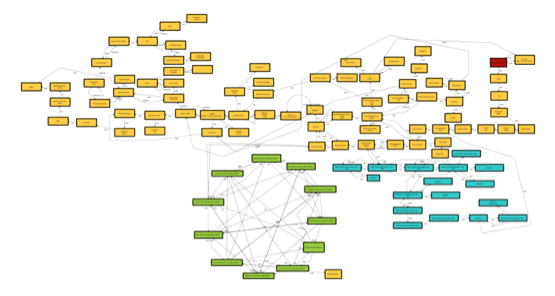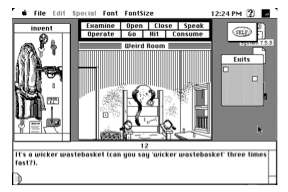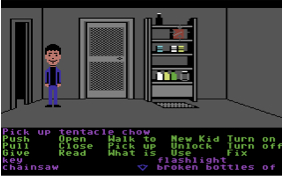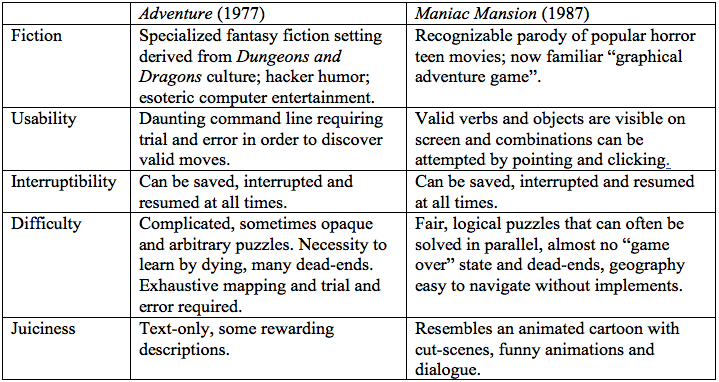Jonathan Lessard![]()
Concordia University
1. Talkin’ about a revolution
At the turn of the 21st century, the video game industry became increasingly interested in catering to so-called « casual gamers”—that is players interested in easily accessible games requiring limited time, effort and expertise. In his book on the phenomenon, Jesper Juul (2010) has termed “Casual Revolution” the process that became particularly observable with the success of the broadly-reaching yet technically underwhelming Nintendo Wii console. If a revolution is the sudden disruption of an established state of affairs, this casual revolution should presuppose the existence of something like a “hardcore regime”. The book’s focus being on the revolution itself as well as casual game design, very little information is given on the status quo ante; only a general perception that video games used to be mostly designed for (and played by) dedicated young male fans.
Juul argues that the casual revolution is in fact a return to video gaming’s arcade roots: “the moment in which the simplicity of early video games is being rediscovered” (2). His reading of the history of video games through the lens of “casualness” suggests an arc that could be schematized this way:
Figure 1: Schematic representation of the « Casual Revolution »
This appealing perspective might effectively reflect reality—or not. In order to judge, one would need to compile data concerning the global “casualness” of the video game offered at different points in time, their targeted demographics, and effective players. If the hardcore-casual divide is to be considered a product of video game discourse, rather than an objective trait of games and players, then we would at least need an analysis of this discourse over time. Until it is more formally constructed, this presupposed “hardcore regime” will remain a mere by-product of the casual revolution’s discovery.
The data gathered for my own research on the history of adventure games (Lessard 2013) is insufficient to make claims covering video game history in general. However, it does add some nuances to what is presumed of video game design prior to the turn of the 21st century as these quotes from past industry leaders should make obvious:
[t]here’s a growing market of consumers that don’t understand zeros and ones, they don’t like big manuals, they want to have fun, they want to enjoy the experience, and they don’t want any obstacles (Tom Frisina, founder of Accolade; Ferrell 1987);
we cannot continue, in the marketplace, living off products that take eight hours to learn to play well and up to 200 hours to complete (Joe Ybarra from Mediagenics; Computer Gaming World 1989).
In the second half of the 1980s, publishers and developers of computer games (as opposed to home console and arcade games) became aware of the necessity to make their games more accessible to new customers, and therefore actively pushed towards more user-friendly design. The impulsion here is not to reconnect with earlier, more casual designs. The foundational computer game genres such as adventure, role-playing, strategy, and simulation have pretty much set the standard for hardcore video games. Contrarily to arcade and console games, early computer games do not easily lend themselves to Juul’s claim that “the first video games had been made for a general audience”. Mainframe games such as Adventure (Crowther and Woods 1977) or The Sumer Game (Dyment 1968) were made for fellow specialists working in high-tech universities and industrial labs. A “casualness” historical curve specifically for computer games would probably not present a “hardcore valley” as it is difficult to imagine games less casual than these (at least in today’s perspective). An intuitive graph of adventure game “casualness” would already show a very different picture:
Figure 2: Adventure games « casualness » curve
In the following sections I will temporarily move away from broad claims concerning the history of video games at large, and focus instead on the specific corpus of computer adventure games through the lens of accessibility (1). This genre (which comprises different labels such as text adventure, graphic adventures, point-and-click adventures, and Myst-likes) (2) is particularly interesting for its progressive evolution from hardcore to casual (still in contemporary terms) while maintaining a recognizable generic identity. This balance of change through continuity enables us to focus on the specific modifications that made the adventure game experience easier to access, less frustrating and more rewarding; and to link this evolution to changes in the broader historical context.
2. Accessibility through cultural familiarity
Adventure, the first adventure game (Crowther and Woods 1977), is a very long and difficult game requiring meticulous mapping (see Figure 1), exhaustive trial and error and even reverse engineering in order to get that “last lousy point”. This game that soon knew an almost universal fame in the computing communities was in many ways a challenge set by a hacker to fellow hackers. With its fantasy fiction, meta-humor, and debugger’s mindset, Adventure certainly looked more like a game for “geeks” than family entertainment.
Figure 3: Personal map of Adventure (Crowther and Woods 1977)
Since Adventure was exclusively playable on industrial mainframe computers, it was perfectly adapted to its potential audience of high-tech specialists. This situation changes when “adventure-type” games begin appearing on home computers, starting with Adventure International’s Adventureland published in 1978 for the TRS-80. Although not as specialized as mainframe computer gamers, the early adopters of micro-computers can hardly be considered as representative of a mass market. They are passionate “hobbyists” ready to invest much time and effort into making their machines work. Accordingly, the first generation of Adventure imitators stays very close to its model.
Still, in the context of the emerging market of personal computer games, developers and publishers need to find arguments to favorably distinguish adventure games from the competition and try to reach new potential players. A new discourse emerges emphasizing the intellectual aspect of adventure games as opposed to the “brainless” reflex challenges of popular arcade and console games. This reflects the perception that early computer game players are very distinct from other types of electronic game fans. In 1982, game designer and columnist Dan Bunten observes that “[t]he great majority of the computer games audience is made up of more intelligent, better educated, relatively affluent elite” (3). This attitude represents not only the complacent self-perception of computer gamers themselves as many publishers adhere to this vision in the early 1980s. According to Jon Loveless of Synapse Software: “’thinking’ games are the wave of the future. People are becoming dissatisfied with the hand-eye co-ordination game” (Sipe 10). The appeal to (and flattery of) players’ intelligence and imagination is particularly obvious in Infocom’s famous “brain” advertisement campaign.
Figure 4: Infocom Ad (Softline 05/83, pp. 6-7)
Infocom, one of the major developers and publishers of adventure games in the first half of the 1980s, is also a major agent in elaborating another aspect of this discourse: adventure games are not so much video games as a new form of interactive literature. To emphasize this orientation, the company adopts the label “interactive fiction” to describe their adventure game in the spring edition of their newsletter (The New Zork Times 1984 1); a move that is further explained two years later in the same publication:
First came « Adventure, » and thus was born the name for an entire category of games. But with Infocom leading the way towards more story-oriented, non-fantasy adventure games, the name became misleading and downright irrelevant. A new name for this kind of entertainment software was needed (The Status Line 1986 6).
Infocom is not the only company to embark on what I’ve termed the “narrative turn” of adventure games. A representative of Sierra On-Line declares in 1983: “People will get tired of an arcade-type game […] Ours are more like reading a novel. We require the use of the mind, not just hand-eye coordination” (Videogaming Illustrated 1983 76).
The association of adventure games to literature (and its dissociation from the hectic and youth-oriented games of arcades and home consoles) helps reduce the cultural gap between adventure games and the general public. The games aren’t more accessible in terms of design but already seem less unfamiliar when perceived as a new form of narrative fiction. Although it isn’t sufficient to make adventure games a genuine popular phenomenon, it allows for unprecedented forays outside the confidential computing communities. An often quoted example is the New York Times Book Review article on “participatory novels” (Rothstein 38) focusing on Infocom’s Deadline (1982). It is also through this interactive fiction angle that computer games first attract academic scrutiny (Niesz and Holland 1985; Buckles 1985).
Once established as a narrative vehicle, adventure games quickly become a convenient gateway to transfer existing intellectual properties. At the 1984 Consumer Electronic Show, three publishers announce computer game series based not only on books such as Bradbury’s Fahrenheit 451 or Stephen King’s The Mist; but also on movies such as Indiana Jones, Rambo and James Bond (see Figure 5). Although these adaptations (and the numerous subsequent ones) will generally not have much success in the established fan-base of the genre, they might have helped attracting new players daunted by the unfamiliarity of the general offer of computer games. As the genre embraces graphical representation, the discourse quickly shifts towards adventure games as interactive films.
Figure 5: Cover art of A View to a Kill (Angelsoft 1985)
3. Accessibility through design
The context of computer games in the second half of the 1980s is already significantly different. The user-base of personal computers is much larger, now including a significant number of people more interested in ready-made software than fiddling with the machine. We could say that a new market of “casual” computer users is now appearing. The audio-visual capacities of computers have also greatly increased, upping the ante for game developers competing to deliver the “hottest” software—that is, making the most of the available technology. This “arms-race” sets in motion the still ongoing trend of ever-increasing game development budgets. In 1985, game designer Chris Crawford could already declare that “We have pretty much passed the period where hobbyists could put together a game that would have commercial prospect” (Darling 48). The problem is exacerbated by the success of the Nintendo NES console which establishes, with its dedicated hardware, a comparison point in terms of what multimedia experience is now available to the great public. Computer game developers and publishers feel this comparison to be unfair as their market is not only much smaller but also plagued with piracy.
It is in this context that we find numerous calls for greater accessibility in computer games such as those quoted in the introduction. For many industry leaders, the solution to the increasing development costs lies in making computer games a mass market item. To achieve this, they need to be more accessible to the general public. As Bing Gordon from Electronic Arts summarizes:
Right now, there’s so much expertise and experience that you need to have in order to get the enjoyment out of a rich and deep computer game, that we’ve shut ourselves off from a part of the marketplace that just wants to sit and be entertained (Ferrell).
Although adventure games had managed to reach out to new audiences by acquiring familiarity and legitimacy through association to literature and film, their design hadn’t changed much. The parser-based interface of graphical adventures is as opaque and daunting as that of the original Adventure, and progress as demanding and punishing. In the second half of the 1980s, the genre will undergo two major shifts touching its interface and puzzle design.
3.1. Interface design
Adventure games are representative of the broader push towards greater accessibility for personal computers. A key element in this process is the introduction of the graphical user interface to the greater public through the Macintosh computer in 1984. Its operating system proposes a convincing alternative to the established paradigm of command line interfacing and thus convinces many that computers don’t have to be programmed to be used. Its core elements (sometimes summarized as WIMP: window, icon, menu, pointer) are immediately imitated by software of all platforms; so much that the word “macintoshization” entered journalistic discourse to describe the phenomenon. In his review of 1985, Charles Ardai of Computer Gaming World writes:
One [trend] was Macintoshization, doing everything possible to make other computers resemble the Mac. This involved windows […] and pull-down menus […], as well as icon-driven systems and mice for all computer systems (Ardai 25).
Adventure games do not escape this trend, and a “macintoshized” title, Enchanted Scepters, appears as early as 1984. The MacVentures series by ICOM initiated by Déjà Vu (1985) attract more attention with its fully realized “point and click” adaptation of the classical adventure game model (see Figure 6). Their design ambition is quite clear: “Our idea was to do an adventure game that fitted into the Mac user interface, […] [o]ne of our ideas was ‘when in doubt, make it work the same way the Finder does’” (Donovan 144).
Figure 6: Déjà Vu (ICOM 1985)
ICOM’s alternative to the parser is appreciated, and Déjà Vu is awarded both “Best Entertainement Product” and “Best New World” at Excellence Software Awards of the Software Publishers Association en 1986. A reviewer of Uninvited writes: “It is much easier to work with than pure text or text and graphic adventure games” (Wagner 41).
Despite a good reception, ICOM’s model is not imitated. The Macintosh remains a marginal machine amongst computer gamers and ports to such established platforms as the Commodore 64 or the up and coming one that is DOS only appear two years later in 1987. The model also ignores the now entrenched feature of a visible player character established by Sierra and its AGI-based games in the wake of King’s Quest (1983). In 1987, Lucasfilm Games’s Maniac Mansion seems to condense all contemporary trends in adventure game design and its point-and-click interface (see Figure 7) retro-fitted to the Commodore 64 becomes a major reference.
Figure 7: Maniac Mansion (Lucasfilm Games 1987)
Both models, however, solve parser-based adventure games’ usability problems in a similar fashion—that is by relieving users of the burden of coming up with valid commands all by themselves. As observed by Fernández-Vara, the traditional command line interface is a perfect example of what user-centered design specialist Donald Norman calls “tyranny of the blank screen” (222). Point-and-click adventure game interfaces make available affordances visible and assist users in phrasing commands that are likely to be understood by the system, thus avoiding irritating “guess the parser” gameplay. Computer Gaming World’s reviewer of Maniac Mansion writes: “The computer makes grammatical sentences out of your joysticking and a click of approval sets your words into action. What could be simpler? […] [T]he interface is one of the most comfortable ever devised” (Ardai 41). In 1990, Sierra launches its own point-and-click engine, thus marking the disappearance of parser-based interfaces in graphical adventure games (1).
3.2. Game design
The parser is not the only hurdle to potential adventure game players in the late 1980s; the genre can also be very trying. Progress is structured around puzzles that are often complicated, opaque, or arbitrary, punctuating player experience with long periods of unrewarding wandering and experimentation. Most players resort to the hint books or telephonic help lines made available by publishers in order to finish the games. In many ways, adventure game design still embodies Adventure’s original hacker mindset of challenging one’s peers. This approach is made particularly obvious in Infocom’s history of Zork in which they describe their design process as a friendly contest between them and the “net randoms”, clever anonymous users that managed to connect to their game through the unprotected ARPAnet :
No one ever officially announced Zork: people would log in to DM (4), see that someone was running a program named Zork, and get interested. They would then “snoop” on the console of the person running Zork, and see that it was an Adventure-like game. From there, it only took a little more effort to find out how to start it up. For a long time, the magic incantation [i.e. command line] was “:MARC;ZORK” (Anderson 7).
It is no surprise that Zork’s puzzles could seem daunting to more casual players when it was designed against such an expert testing base.
Towards the end of the 1980s, this antagonistic “try to beat me” attitude towards players begins to be challenged in favor of a greater attention to users’ experience. In the background of this process is the progressive recognition of computer game design as a legitimate specialty divorced from programming. Game pioneer Don Daglow recalls that before the middle of the 1980s: “Management regarded [game designers’] programming skills as the source of their value and game design was often snorted as an illusory talent » (Daglow 42). The movement is in large part spearheaded by visionary game designer Chris Crawford who publishes the first book devoted to computer game design in 1984 (Crawford 1984), launches the Journal of Computer Game Design in 1987 (5) and inaugurates the Computer Game Developer Conference in 1988. The two latter will become important platforms of networking and discussion for game designers.
Computer game design discourse of the time reflects developers and publishers’ concern with existing models being inappropriate for new audiences. In her article “Reassessing Interactivity”, Brenda Laurel acknowledges that “we have been trying to please ourselves. […] From the venerable computer jocks who brought you Adventure and Space War to the Infocom junkies of today, being a ‘good gamer’ is very closely related to being a hacker” (7). She concludes that: “Moving away from old models of ‘rich interactivity’ is not all bad. […] It leads us to rediscover simplicity. It encourages us to make products that are more accessible to more people”. Such an epiphany parallels Juul’s observations on the latter casual revolution: “with casual games, video game developers have stopped making games just for themselves and are reaching underserved audiences” (150).
Until then, adventure games had entertained a tenuous relationship with game design. Although their makers have used the title of game designer from the onset, many of them think of themselves rather as interactive storytellers. Roberta Williams, one of the most famous designers of the genre, still declares in 1992: “I hate to call them games […] I think of them more as interactive stories” (Busch 41). It is still not clear at this point how “interactive fiction” relates to games and how it can benefit from general game design know-how. The genre constitutes an original form with no established aesthetic criteria as to what would make a good adventure game. The first generation of designers had played only a handful of adventure games (all direct imitators of Adventure) before making their own. In other words, the design space of the game architecture (6) established by Adventure had not been explored and experienced enough to allow any deviation from the initial model.
In the second half of the 1980s, nearly ten years have passed and hundreds of adventure games have been made and played. We can trace across reviews the elaboration of a grassroots set of aesthetic criteria concerning puzzles. For example, one shouldn’t need to “unravel the mind of the designer instead of dealing with the situation directly” (Katz 79); or “take actions that are motivated only by the information [you] gained in a ‘previous life’” (McGath 22); or need external information like this “skullsmasher that’s near impossible without information obtained from the film” (QuestBusters 1986 1); or get stuck “in a dead-end, which occurred with regrettable frequency” (Olsen 20). In brief, the general call is for adventure games to be fair in their challenges.
Not all studios are sensitive to this shift in game design. Sierra, the major player in the genre, doesn’t seem to see any need for change as it remains extremely successful by focusing on technical innovation and diverse pop-culture derived storytelling. In-house designer Al Lowe recalls: “I believe we had one meeting where all of the designers got into one room and talked, but that was the end of the formal exchange of knowledge. And that was right towards the end – it was very, very late” (Kalata 82). The picture is very different in the smaller Lucasfilm game studio where reportedly: “the division had retained the research-focused attitude of the rest of the Computer Division” (Smith 68). Designer Ron Gilbert declares in 1991: “what I set out to do with Maniac Mansion was to fix all the things I didn’t like about adventure games” (The Adventurer 1991 4). The results of this process are not unnoticed. Charles Ardai of Computer Gaming World writes: “Unlike many works of interactive fiction, Maniac Mansion spins a coherent and interesting tale without frustrating the player” (Ardai 40).
We know of Gilbert’s adventure game design perspective through his famous 1989 Journal of Computer Game Design article: “Why Adventure Games Suck”. Despite its pessimistic title, Gilbert details a series of “golden rules” to better the genre. Their titles are:
- End objectives need to be clear
- Sub-goals need to be obvious
- Live and learn
- Backwards puzzles
- I forgot to pick it up
- Puzzles should advance the story
- Real time is bad drama
- Incremental rewards (new graphics, characters, plot elements)
- Arbitrary puzzles
- Reward intent
- Unconnected events
- Give the player options (Gilbert 4).
This “manifesto” implicitly acknowledges the current aesthetic consensus pertaining to adventure game puzzles mentioned earlier. It also reflects a clear vision of what the optimal adventure game experience should be and the design decision it entails.
Contrarily to interface design, game design is not about removing all difficulty in the achievement of a goal but to create the conditions for interesting difficulty. The problem often consists of identifying what form of difficulty is desirable in order to remove all other unwanted friction. Until now, most adventurer game designers had intuitively strived for good “interactive storytelling” without really defining what that would be or how that would relate to puzzles, the more ludic aspect of the software. Gilbert has a clearer idea of how everything should work together to support that interactive fiction experience. He considers that the player needs to be maintained in a state of “suspension of disbelief” which “disappears every time the player has to restore a saved game or ends up pounding his head on the desk in frustration” (Gilbert 1989, 4). To maintain the player in what would now be called “immersion”, the game should thus limit player-character death (an omnipresent trait of contemporary adventure games) and reduce bottlenecks with fair puzzles that can be solved non-linearly. Any difficulty not contributing directly to that identified core experience should be smoothed out; including not only miscommunication with the parser (as noted in the previous subsection) but also the tedious player-character positioning required in Sierra games. The new path-finding feature of the engine developed for Maniac Mansion, is lauded for removing all “silliness about ‘you’re not close enough’ to pick up an item” (Scorpia 40).
4. How many revolutions?
Towards the end of the 1980s, adventure games seem to have achieved their own little “casual revolution”. We can assess the change through Juul’s elements of casual game design (30):
That adventure games have achieved a high level of accessibility at this time is further supported by the fact that the model is used for young children’s games such as the Putt-Putt series (Humongous 1992) and by the unprecedented success of Myst in 1993 (Cyan) which introduces computer gaming to a very broad audience (Juul 27).
Apparently, the casual revolution of the 2000s is perhaps not as revolutionary as it seemed. There is a clear precedent of a sector of the digital game industry identifying accessibility as a problem in reaching new players within a less specialized audience. Question is: how many casual revolutions can there be? Perhaps the most general conclusion we can draw is that these constitute sub-stories within the greater narrative of the video game industry’s continuous growth through the production of new audiences. This narrative being the sum of smaller-scale initiatives such as adapting existing genres, creating new ones, developing new platforms, new peripherals or devising new marketing strategies. The presupposed “hardcore valley” described earlier can itself be interpreted as a response to the aging and increasing game literacy of the Nintendo children. It is probably not so much a shift as an additional layer to the existing video game offer as very accessible games continued to be published throughout this period on all platforms. At the turn of the century, this area might have been the most active and/or the most visible (being so violent, focused on teenagers and fostering addictive behaviors), thus giving the general perception that video games had become hardcore territory.
The problems raised here are symptomatic of the current state of knowledge on video game history. First of all, it is still extremely limited. The data that would help assess the existence or scope of a casual revolution is still unavailable. Obvious things like historical player demographics, play habits or genre preferences are still largely unknown. This case study also highlights deep fragmentation lines in video game history which make general claims about it very precarious. Clearly, a history of game accessibility and design will be very different if told from the perspective of computer games rather than that of arcade or home console. Future historical work will need to document and account for the communities clustered around platforms, genres or places and their unique trajectories.
Notes
(1) The term “casual game” being anachronistic in contexts prior to the late 1990s (and also loaded with connotations concerning the kinds of games and players it denotes), I’m preferring the general notion of accessibility referring to the time, efforts and background experience needed to engage a specific game and progress towards its goals.
(2) As is often the case with genre, there is no objective consensus as to what “adventure games” designates. Here we are following one of the major interpretative traditions linking together the enumerated chain of sub-genres associated mostly with the personal computer platform.
(3) It might seem a bit late but the company is well established in the PC/DOS market which was also late in adopting GUIs. Significantly, 1990 is also the year of Windows 3.0, the first relatively successful graphical operating system on IBM compatibles.
(4) DM refers to MIT’s Dynamic Modeling Group.
(5) Crawford remained the editor, self-publisher and main contributor of the journal until 1996.
(6) I mean by that the high-level design configuration that is roughly similar in all adventure games and which allows for the reproduction of a familiar play experience.
References
« A View to Kill ». Questbusters juill. 1986 : 1‑2. Print.
Anderson, Tim. « The History of Zork–First in a Series ». The New Zork Times 1985 : 6‑7;11. Print.
Ardai, Charles. « The Doctor is in: an Appointment with Terror in Activision’s Maniac Mansion ». Computer Gaming World May 1988 : 40‑41. Print.
—. « Year in Review ». Computer Gaming World Dec. 1986 : 20‑26. Print.
Bunten, Dan. « Real World Gaming ». Computer Gaming World 1982 : 31‑32. Print.
Busch, Kurt. « A Game Designer Designs the Future ». InterAction (1992): 40‑42. Print.
« By Any Other Name ». The Status Line 1986 : 6. Print.
Crawford, Chris. The art of computer game design. Berkeley, Calif: Osborne/McGraw-Hill, 1984. Print.
Daglow, Don. « Over the River and through the Woods: the Changing Role of Computer Game Designers ». Computer Gaming World Aug. 1988 : 18;42. Print.
Darling, Sharon. « Birth of a Computer Game ». Compute! Feb. 1985 : 48. Web. 12 Aug 2012. http://www.atarimagazines.com/compute/issue57/computer_game.html
Donovan, Tristan. Replay: The History of Video Games. N.p. : Yellow Ant, 2010. Print.
« Eye on Computers ». Videogaming and Computergaming Illustrated juill. 1983 : 76‑79. Print.
Fernández-Vara, Clara. « Shaping Player Experience in Adventure Games: History of the Adventure Game Interface ». Extending Experiences – Structure, Analysis and Design of Computer Game Player Experience. Ed. H. W. Leino Olli. Rovaniemi: Lapland University Press, 2008. 210‑227. Print.
Ferrell, Keith. « The Future of Computer Games: Ten Industry Leaders Speak Out ». Compute! 90 (1987): 14. Print.
« Frank Answers to the Ten Most Frequently Asked Questions ». The New Zork Times 1984 : 1‑2. Print.
Gilbert, Ron. « Why Adventure Games Suck ». Journal of Computer Game Design 3.2 (1989): 4. Print.
« Infocom’s West Coast Move Stirs Controversy ». Computer Gaming World Aug. 1989 : 10. Print.
Juul, Jesper. A Casual Revolution: Reinventing Video Games and Their Players. The MIT Press, 2012. Print.
Kalata, Kurt, éd. The Guide to Classic Graphic Adventures. N.p.: CreateSpace, 2011. Print.
Katz, Arnie. « Passport to Adventure ». Electronic Games mai 1982 : 78‑80. Print.
Laurel, Brenda. « Reassessing Interactivity ». The Journal of Computer Game Design 1.3 (1987): 7‑10. Print.
Lessard, Jonathan. « Histoire formelle du jeu d’aventure sur ordinateur (le cas de l’Amérique du nord de 1976-1999) ». Ph. D. Cinema Studies. Université de Montréal, 2013. Print.
McGath, Gary. Compute’s Guide to Adventure Games. Radnor: Compute! Books, 1984. Print.
Niesz, Anthony J., et Norman N. Holland. « Interactive Fiction ». Critical Inquiry 11.1 (1984): 110‑129. JSTOR. Web. 3 June 2010. http://www.jstor.org/stable/1343292
Olsen, John. « The Blade of Blackpoole: Sharpen your Sword for High Adventure on your C-64 ». RUN Mar. 1984 : 20‑21. Print.
Rothstein, Edward. « Reading and Writing; Participatory Novels ». The New York Times 8 May 1983. NYTimes.com. Web. 20 Dec. 2012. http://www.nytimes.com/1983/05/08/books/reading-and-writing-participatory-novels.html
Scorpia. « Heretofore Untold, Scorpia Reveals the Secret of Monkey Island ». Computer Gaming World Dec. 1990 : 40;43‑44;116. Print.
Sipe, Russell. « Computer Games in 1983: A Report ». Computer Gaming World 1983 : 10‑11. Print.
Smith, Rob. Rogue Leaders: The Story of LucasArts. San Francisco: Chronicle Books, 2008. Print.
« The Evolution of Lucasfilm Games ». The Adventurer 1991 : 4‑5. Print.
Wagner, Roy. « Uninvited: A Guided Tour to a Macabre Mansion ». Computer Gaming World Aug. 1987 : 40‑41. Print.
Games
Adventure. William Crowther, Don Woods. 1977.
Adventureland. Adventure International. Adventure International. 1978.
Deadline. Infocom. Infocom. 1982.
Déjà-Vu. ICOM Simulations. Mindscape. 1985.
Enchanted Scepters. Silicon Beach Software. Silicon Beach. 1984.
King’s Quest. Sierra On-Line. Sierra On-Line. 1983.
Maniac Mansion. Lucasfilm Games. Lucasfilm Games. 1987.
Myst. Cyan. Brøderbund. 1993.
Sumer Game, the. Doug Dyment. 1968.






